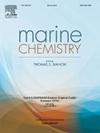钐(Sm3+)和铜(Cu2+)与溶解有机物的络合性能
IF 2.5
3区 地球科学
Q2 CHEMISTRY, MULTIDISCIPLINARY
引用次数: 0
摘要
本研究调查了来自苏瓦尼河的钐 (III) 在天然有机物、标准腐殖酸和富勒酸存在下的分型情况。采用荧光淬灭和时间分辨激光荧光光谱法(TRLFS)分析各种样品,使用 Sm3+ 和 Cu2+ 的对数添加量。应用 1 L:1 M 和 1 L:1 M:H 模型来考虑 pH 值的影响,得出了与 pH 值无关的络合剂参数 KSm 和 KCu 以及 CLSm 和 CLCuth,它们揭示了特定的结合位点。与 Cu2+ 相比,腐植酸与 Sm3+ 的亲和力明显更高。SRNOM、SRHA 和 SRFA 与 Sm3+ 的络合常数对数分别为 5.4、5.2 和 4.7。荧光淬灭分析确定了与溶解有机物有关的两种不同的荧光成分,它们对 Sm3+ 和 Cu2+ 的亲和力随 pH 值的变化而不同。腐植酸对 Sm3+ 的络合能力最高,这与它们的结构特性有关,每克 SRNOM、SRHA 和 SRFA 对 Sm 的络合能力分别为 4.77 10-4、0.82 和 4.46 10-3 摩尔。荧光响应的时间解卷积显示了一种三指数衰减,在 Sm3+ 或 Cu2+ 滴定过程中,三个寿命(τ1、τ2 和 τ3)保持相对恒定,这证实荧光淬灭主要是一种静态机制。物种模型显示,随着盐度的增加,淡水中的腐殖质相关复合物会转变为海水中的碳酸盐复合物。这些发现凸显了准确描述 DOM 复合物特性对了解痕量金属环境行为的重要性,尤其是对河口系统中盐度和碳浓度梯度的响应。本文章由计算机程序翻译,如有差异,请以英文原文为准。

Samarium (Sm3+) and copper (Cu2+) complexation property with dissolved organic matter
This study investigates the speciation of Samarium (III) in the presence of natural organic matter, standard humic and fulvic acids from the Suwannee River. Fluorescence quenching and Time-Resolved Laser Fluorescence Spectroscopy (TRLFS) were employed to analyze various samples, using logarithmic additions of Sm3+ and Cu2+. The 1 L:1 M and 1 L:1 M:H models were applied to account for pH effects, yielding pH-independent complexant parameters KSm and KCu as well as that revealed specific binding sites. A notably higher affinity was observed for humic acids with Sm3+ compared to Cu2+. The logarithms of the complexation constant for the Sm3+ were 5.4, 5.2 and 4.7 for SRNOM, SRHA and SRFA, respectively. Fluorescence quenching analyses identified two distinct fluorescent components related to dissolved organic matter, showing different affinities for Sm3+ and Cu2+ that varied with pH. Humic acids exhibited the highest complexation capacity for Sm3+, attributed to their structural properties, with complexation capacities of 4.77 10−4, 0.82 and 4.46 10−3 mol of Sm per g of SRNOM, SRHA and SRFA, respectively. Temporal deconvolution of fluorescence responses revealed a tri-exponential decay with three lifetimes (τ1, τ2 and τ3) remaining relatively constant during Sm3+ or Cu2+ titrations, confirming that the fluorescence quenching is primarily a static mechanism. Speciation modeling demonstrated a shift from humic-associated complexes in freshwater to carbonate complexes in seawater as salinity increases. These findings highlight the importance of accurately characterizing DOM complexation properties to understand the environmental behavior of trace metals, particularly in response to salinity and carbon concentration gradients in estuarine systems.
求助全文
通过发布文献求助,成功后即可免费获取论文全文。
去求助
来源期刊

Marine Chemistry
化学-海洋学
CiteScore
6.00
自引率
3.30%
发文量
70
审稿时长
4.5 months
期刊介绍:
Marine Chemistry is an international medium for the publication of original studies and occasional reviews in the field of chemistry in the marine environment, with emphasis on the dynamic approach. The journal endeavours to cover all aspects, from chemical processes to theoretical and experimental work, and, by providing a central channel of communication, to speed the flow of information in this relatively new and rapidly expanding discipline.
 求助内容:
求助内容: 应助结果提醒方式:
应助结果提醒方式:


